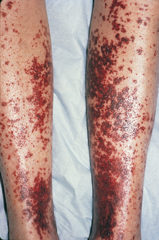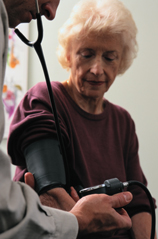MKSAP Quiz: Rash, pain, fever and fatigue
A 48-year-old woman is evaluated for a rash on her legs, arthralgia and myalgia, low-grade fever, and fatigue of 4 weeks' duration. Over the past week, she has had numbness and burning pain in her left foot; she also feels that this foot is slightly “dragging,” and she has tripped and fallen several times. Fifteen years ago, she used illicit injection drugs for a 3-year period.
On physical examination, temperature is 37.7°C (99.8°F), blood pressure is 150/100 mm Hg, pulse rate is 88/min, and respiration rate is 18/min. Cardiopulmonary examination is normal. Skin examination findings are shown.

Abdominal examination reveals hepatomegaly. She has a left foot drop, and there is no synovitis.
Laboratory studies:
| Leukocyte count | 10,400/µL (10.4 × 109/L) |
| Platelet count | 323,000/µL (323 × 109/L) |
| Total protein | 7.9 g/dL (79 g/L) Albumin: 2.9 g/dL (29 g/L) |
| Serum creatinine | 1.6 mg/dL (122.1 µmol/L) |
| Total bilirubin | 0.9 mg/dL (15.4 µmol/L) |
| Alkaline phosphatase | 84 U/L |
| Alanine aminotransferase | 95 U/L |
| Aspartate aminotransferase | 108 U/L |
| Rheumatoid factor | 232 U/mL (232 kU/L) |
| C3 | 32 mg/dL (320 mg/L) |
| C4 | 8 mg/dL (80 mg/L) (normal range, 13-38 mg/dL [130-380 mg/L]) |
| Antinuclear antibodies | Negative |
| Urinalysis | 3+ protein; 2+ blood; 15-20 erythrocytes, 5-10 leukocytes/hpf |
A chest radiograph is normal.
Which of the following diagnostic studies should be performed next?
A. ANCA
B. Anti–cyclic citrullinated peptide antibodies
C. Anti–double-stranded DNA antibodies
D. Serum cryoglobulin
Answer and critique
The correct answer is D: Serum cryoglobulin. This question can be found in MKSAP 15 in the Rheumatology section, item 9.
This patient has constitutional symptoms, palpable purpura, and a foot drop consistent with mononeuritis multiplex. In addition, her elevated blood pressure, elevated serum creatinine level, proteinuria, and hematuria are suggestive of glomerulonephritis. This clinical presentation is compatible with many forms of vasculitis, but cryoglobulinemic vasculitis is the most likely diagnosis in a patient with hepatomegaly, abnormal liver chemistry studies, hypergammaglobulinemia (suggested by the elevated total protein and low albumin level), profound hypocomplementemia, and the presence of rheumatoid factor. A serum cryoglobulin assay is the most appropriate next diagnostic step in this patient.
Cryoglobulins are immunoglobulins that precipitate in the cold and have rheumatoid factor activity (that is, they bind to the Fc portion of immunoglobulins). Type II cryoglobulinemia is most commonly associated with vasculitis, and cryoglobulins in this setting are monoclonal and are bound to polyclonal IgG. Approximately 85% to 95% of cases of type II cryoglobulinemia are associated with hepatitis C virus infection, which this patient most likely has based on her constitutional symptoms, history of injection drug use, and liver chemistry study abnormalities.
The ANCA-associated vasculitides (Wegener granulomatosis, microscopic polyangiitis, and Churg-Strauss syndrome) may be associated with purpura, mononeuritis multiplex, and glomerulonephritis. However, none of these conditions would explain this patient's hypocomplementemia, hypergammaglobulinemia, or high titers of rheumatoid factor.
An anti-cyclic citrullinated peptide antibody assay would be warranted in a patient in whom rheumatoid arthritis is suspected. This patient is rheumatoid factor positive, but her clinical presentation is more consistent with vasculitis than rheumatoid arthritis. Palpable purpura is rarely associated with rheumatoid arthritis and usually develops only in patients with long-standing erosive rheumatoid arthritis, which is not compatible with this patient's history. Rheumatoid arthritis occasionally is associated with the presence of cryoglobulins, but cryoglobulins in patients with rheumatoid arthritis are typically polyclonal (type III) and are not associated with vasculitis.
Anti-double-stranded DNA antibodies are highly specific for systemic lupus erythematosus (SLE). SLE may manifest as mononeuritis multiplex, purpura, glomerulonephritis, and hypocomplementemia but is not usually associated with abnormal results on liver chemistry studies. In addition, more than 99% of patients with SLE have antinuclear antibodies, which are absent in this patient.
Because patients with hepatitis C virus infection commonly have coinfection with HIV and share the same risk factors for hepatitis B, screening for infection with hepatitis B and C virus as well as HIV also would be indicated in this patient.
Key Point
- Cryoglobulinemic vasculitis secondary to hepatitis C virus infection may be associated with hepatomegaly, abnormal findings on liver chemistry studies, hypergammaglobulinemia, hypocomplementemia, and the presence of rheumatoid factor.





